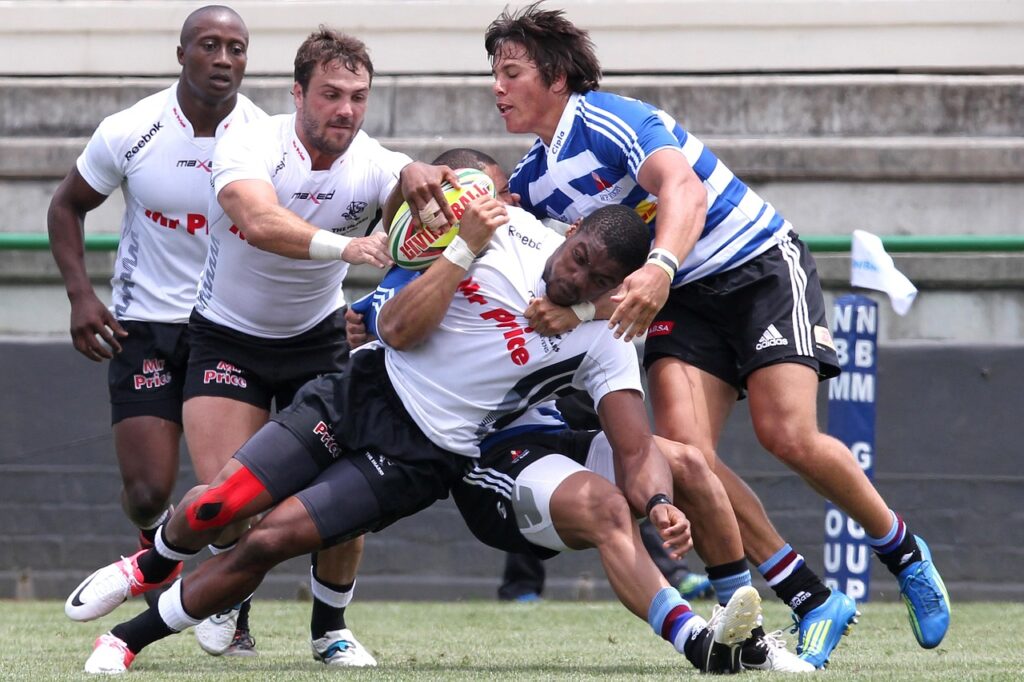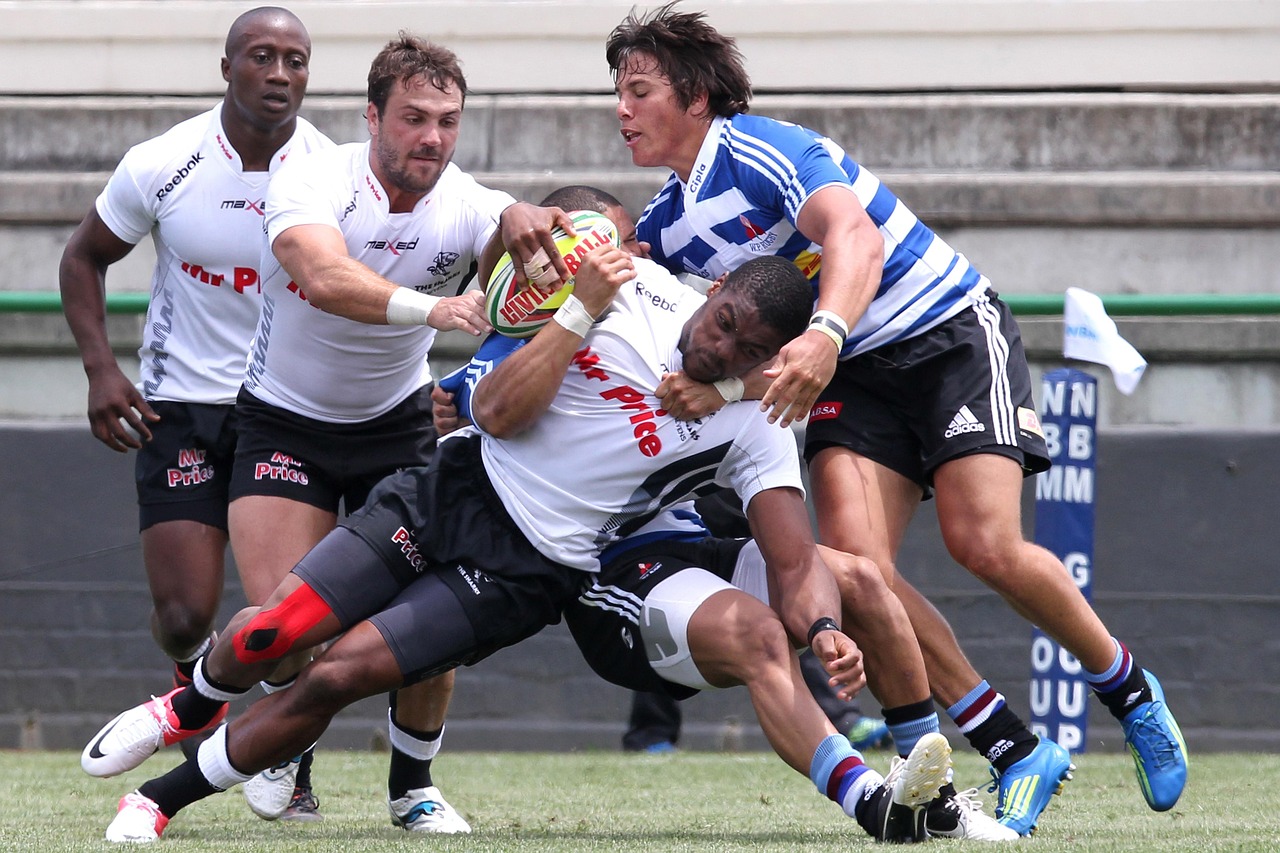Rugby is a high-contact sport that demands strength, speed, and resilience. Thigh taping is a widespread practice among players, particularly forwards like props and hookers, who face intense physicality in scrums and lineouts.
The tape, often rigid zinc oxide or elastic kinesiology tape, is applied around the quadriceps or hamstrings to support muscles, enhance performance, and protect against injuries.
Thigh taping isn’t just about function—it also carries psychological and cultural weight. From stabilizing muscles to aiding teammates in lineouts, it’s a small but impactful part of rugby.
This guide will break down why rugby players tape their thighs and how you can use this technique effectively.
Why Do Rugby Players Tape Their Thighs? Key Reasons for Thigh Taping in Rugby

Why do rugby players tape their thighs? Here are the main reasons this practice is so common:
1. Support and Injury Prevention
Thigh taping supports the quadriceps and hamstrings, which endure significant stress during rugby’s explosive movements. Benefits include:
- Muscle Stability: Limits overextension to reduce strain.
- Joint Support: Indirectly stabilizes knees and hips.
- Injury Reduction: Lowers the risk of muscle pulls or tears.
According to PhysioRoom, taping can decrease injury risk by enhancing muscle and joint stability.
2. Improved Performance in Scrums and Lineouts
Thigh taping offers practical advantages, especially for forwards:
- Lineout Lifting: Tape provides grip for lifters, making it easier to hoist players safely.
- Scrum Stability: Reinforces the thighs for a stronger, more stable scrum position.
Brands like Canterbury often emphasize taping in their performance guides.
3. Protection from Abrasions and Impact
Rugby’s rough nature exposes players to cuts and bruises.
- Shields Skin: Acts as a barrier against turf burns or opponent contact.
- Cushions Impact: Reduces bruising from tackles.
4. Psychological Boost and Team Identity
Taping has mental and cultural benefits:
- Confidence: The ritual of taping prepares players mentally for the game.
- Team Unity: Matching tape styles fosters camaraderie.
These factors make thigh taping a staple in rugby.
Types of Tape Used in Rugby
Different tapes serve different purposes in rugby. Below is a table summarizing the main types used for thigh taping:
| Tape Type | Purpose | Features | Best For | Example Brands |
|---|---|---|---|---|
| Rigid Tape | Firm support and grip for lineouts/scrums | Non-elastic, durable, zinc oxide-based | Forwards needing stability | Leukotape, Strappal |
| Kinesiology Tape | Muscle support and flexibility | Elastic, breathable, colorful | Injury prevention, recovery | KT Tape, RockTape |
| Cohesive Bandages | Light support and skin protection | Self-adhesive, flexible, easy to remove | Temporary taping, added protection | Co-Flex, Vetrap |
How to Tape Your Thighs for Rugby
Ready to tape your thighs? Here’s how to do it right.
Step-by-Step Guide
- Prepare the Skin: Clean and dry the thigh. Shave hair if needed to prevent irritation.
- Choose Tape: Use rigid tape for lineouts or kinesiology tape for muscle support.
- Apply Base Layer: Use pre-tape underwrap or adhesive spray to protect skin.
- Tape the Thigh: For lineouts, apply 2-3 horizontal strips of rigid tape around the mid-thigh, overlapping slightly. For muscle support, use kinesiology tape in a fan or spiral pattern over the quadriceps or hamstrings.
- Secure and Test: Ensure tape is snug but not restrictive. Test movement for comfort.
- Remove Carefully: Peel tape slowly, using oil if needed to avoid skin damage.
For a visual guide, check tutorials on Rugby World.
Common Mistakes to Avoid
- Over-Tightening: Restricts blood flow or causes discomfort.
- Poor Skin Prep: Dirty or wet skin reduces tape adhesion.
- Ignoring Skin Health: Prolonged taping can cause irritation.
Proper technique maximizes the benefits of thigh taping.
Should You Tape Your Thighs? A Quick Checklist
Unsure if thigh taping is for you? Use this checklist:
What’s your role on the team?
A) Forward (e.g., prop, hooker)
B) Back (e.g., wing, fullback)
C) Not a player (e.g., fan, coach)
Do you participate in lineouts or scrums?
A) Yes, often
B) Rarely or never
Are you prone to thigh injuries?
A) Yes (e.g., strains, pulls)
B) No
Do you want grip for lifting?
A) Yes (e.g., for lineouts)
B) No
Do you value the psychological boost of taping?
A) Yes
B) No
Results:
- Mostly A’s: Thigh taping is likely beneficial, especially for forwards. Try rigid tape for lineouts or kinesiology tape for support.
- Mostly B’s: Taping may not be essential but could offer protection or confidence.
- Mixed Answers: Experiment with taping during high-contact games.
Caring for Taped Skin and Preventing Irritation
Taping can stress the skin, so follow these tips:
- Use Pre-Tape Underwrap: Protects against adhesive irritation.
- Clean Post-Game: Gently wash to remove adhesive residue.
- Moisturize: Apply a gentle lotion to prevent dryness.
- Take Breaks: Avoid daily taping to let skin breathe.
- Monitor Reactions: Stop taping if redness or itching persists.
The Science and Culture Behind Thigh Taping
The science of thigh taping is rooted in biomechanics. Studies, like those cited by RugbyPass, show taping reduces muscle fatigue and stabilizes joints, lowering injury risk. Kinesiology tape, for example, lifts the skin to improve blood flow and reduce swelling.
Culturally, thigh taping is a rugby tradition. From the All Blacks’ meticulous strapping to local clubs’ colorful designs, it’s a symbol of commitment. Players like Maro Itoje use taping for both function and flair, as seen in Rugby World Cup matches. Matching tape styles also strengthens team unity.
Where to Buy Rugby Taping Supplies
Need taping gear? Try these sources:
- Sporting Retailers: Lovell Rugby and Pro:Direct Rugby stock rigid and kinesiology tapes.
- Medical Suppliers: PhysioRoom offers professional-grade supplies.
- Online Marketplaces: Amazon and eBay provide affordable options, but check reviews for quality.
- Local Pharmacies: Stock basic tapes for quick purchases.
Choose high-quality tape for durability and skin safety.
FAQ: Common Questions About Thigh Taping in Rugby
Why do rugby players tape their thighs instead of other areas?
Thighs are taped because they’re heavily used in running, tackling, and scrummaging. Taping supports muscles, aids lineout lifting, and protects skin.
Does thigh taping prevent all injuries?
No, but it reduces the risk of muscle strains and provides stability, as supported by studies from PhysioRoom.
Can backs benefit from thigh taping?
Yes, backs can use kinesiology tape for muscle support and injury prevention, though it’s more common among forwards.
How long can I keep tape on my thighs?
Remove tape after each game or practice to avoid skin irritation. Kinesiology tape can stay on for 1-3 days if applied correctly.
Is thigh taping allowed in all rugby matches?
Yes, taping is permitted under World Rugby regulations, provided it’s safe and doesn’t cover illegal padding.
Conclusion
Why do rugby players tape their thighs? It’s a powerful combination of injury prevention, performance enhancement, skin protection, and psychological boost.
From aiding lineout lifts to stabilizing muscles, thigh taping is a game-changer for many players, especially forwards. Use our table, checklist, and FAQ to understand and apply this technique effectively.
Whether you’re charging into a scrum or cheering from the sidelines, thigh taping is a key part of rugby’s DNA.
Do you tape your thighs for rugby, or are you thinking about trying it? Drop your thoughts in the comments!
